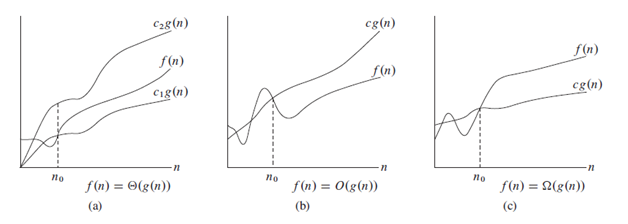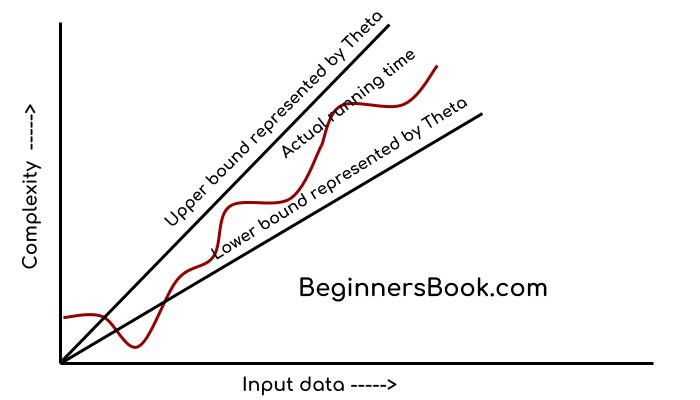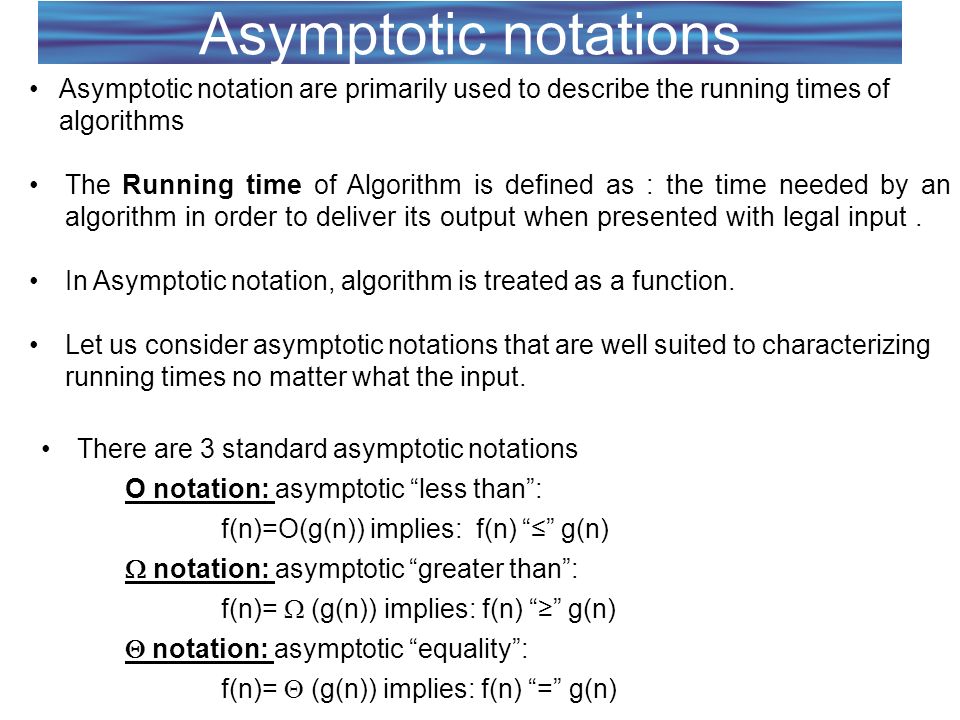Explain Different Types of Asymptotic Notation
One important advantage of big-O notation is that it makes algorithms much easier to analyze since we can conveniently ignore low-order terms. G n Ω f n is similar to a b.

Asymptotic Notations For The Analysis Of Algorithms By Mahi Medium
Theta Notation θ This notation represents the average complexity of an.

. Big Oh describes the worst-case scenario. There are mainly three asymptotic notations. I Big Oh notationO.
These durations are denoted using asymptotic notations. Big Oh Notation Ο. Asymptotic Upper bound The function f nO g n if and only if there exist a positive constant C and K such that f n C g n for all.
Top 5 Asymptotic Notations 1. It concisely captures the important differences in the asymptotic growth rates of functions. O big oh big omega and big theta.
This notation gives upper bound as well as lower bound of an algorithm. The notation Οn is the formal way to express the upper bound of an algorithms running time. Asymptotic Notations are languages that allow us to analyze an algorithms run-time performance.
Running time complexity given as O n Logarithmic time algorithm. G n O f n is similar to a b. For example an algorithm that runs in time.
Often called theta notation. As far as I know Big-O notation is for worst cast omega is for best case and theta is for average case. Running time complexity given as O.
Following are the commonly used asymptotic notations to calculate the running time complexity of an algorithm. Omicron is for asymptotic upper bound omega is for lower bound and theta is for tight bound which is both an upper and a lower bound. Big-Θ is used when the running time is the same for all cases big-O for the worst case running time and big-Ω for the best case running time.
F n o g n if and only if g n ω f n Since these properties hold for asymptotic notations analogies can be drawn between functions f n and g n and two real numbers a and b. Usually the time required by an algorithm falls under three types. Asymptotic Notations identify running time by algorithm behavior as the input size for the algorithm increases.
Asymptotic Notations are languages that allow us to analyze an algorithms running time by identifying its behavior as the input size for the algorithm increases. If the lower and upper bound of an algorithm are different then the complexity cannot be expressed with theta. Iffn Ogn we say thatgn is an upper bound onfn.
As pointed out in the previous section the efficiency analysis framework con-centrates on the order of growth of an algorithms basic operation count as the principal indicator of the algorithms efficiency. Big oh Notation Omega Notation Ω Theta Notation θ Big oh Notation O Big O notation is an asymptotic notation that measures the performance of an algorithm by simply providing the order of growth of the function. The asymptotic notation of an algorithm is classified into 3 types.
Big-oh notation0 Big-O notation represents the upper bound of the running time of an algorithm. We say thatfn is Big-O ofgn written asfn Ogn iff there are positive constantscandn0such that 0 fn cgn for alln n0. A graphical analysis of Big O Notation Omega Notation and Theta Notation with respect to their input is done to clearly understand each type of asymptotic notations and differences between each type of.
Omega Notation Ω Omega Ω notation specifically describes best case scenario. Asymptotic Notation 14 Asymptotic Bounds and Algorithms In all of the examples so far we have assumed we knew the exact running time of the algorithm. Direct link to JaCoB AcKeRmAn _ ツ_s post Asymptotic Notations are.
Big O big Theta Θ and big Omega Ω. According to Big O notation we have five different categories of algorithms. Big-O Notation Ο Big O notation specifically describes worst case scenario.
In general it may be very difficult to determine the exact run ning time. Then we define the three most common asymptotic bounds as follows. 10n 3 24n 2 3n log n 144.
The commonly used asymptotic notations used for calculating the running time complexity of an algorithm is given below. Different types of asymptotic notations are used to describe the algorithm complexity. Asymptotic Notation is used to describe the running time of an algorithm - how much time an algorithm takes with a given input n.
This is also known as an algorithms growth rate. Running time complexity given as O 1 Linear time algorithm. To represent the above cases for run time there are four asymptotic notations.
To compare and rank such orders of growth computer scientists use three notations. Asymptotic Notation Upper Bound O- Big Oh is the most commonly used notation. It represents the upper bound of the algorithm.
When the input array is neither sorted nor in reverse order then it takes average time. There are three different notations. Types of Data Structure Asymptotic Notation 1.
This is called big-O notation. Thus it gives the worst-case complexity of an algorithm. This notation gives an upper bound of an algorithm that bounds the function from above.
Different types of asymptotic notations such as Big O Notation Omega Notation and Theta Notation are discussed along with appropriate examples. Thus we will try to determine a bounds without computing the exact running time. G n Θ f n is similar to a b.
Letfbe a nonnegative function.

Data Structure Asymptotic Notation

Data Structure Asymptotic Notation

Asymptotic Notation Faculty Name Ruhi Fatima Ppt Video Online Download
0 Response to "Explain Different Types of Asymptotic Notation"
Post a Comment